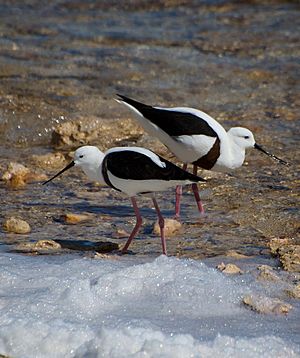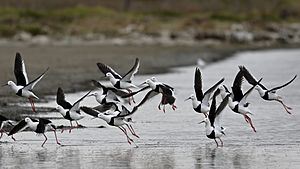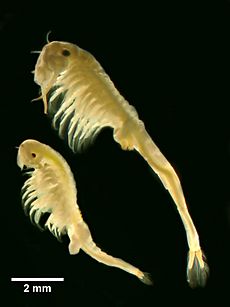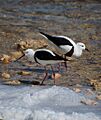Banded stilt facts for kids
Quick facts for kids Banded stilt |
|
|---|---|
 |
|
| Banded stilts, Rottnest Island |
|
| Conservation status | |
| Scientific classification | |
| Genus: |
Cladorhynchus
|
| Species: |
leucocephalus
|
 |
|
| Banded stilt natural range | |
The banded stilt (Cladorhynchus leucocephalus) is a unique Australian bird. It's a type of wader, meaning it spends its time in shallow water. This bird is part of the stilt and avocet family, called Recurvirostridae.
Banded stilts are known for their special red-brown band across their chest. This band is brightest when they are ready to breed. Younger birds and adults not breeding have a fainter band or none at all. Their feathers are mostly black and white, and their eyes are dark brown. Baby banded stilts are born with soft white feathers, which is unusual for wader birds.
These birds are nomadic, meaning they travel a lot. They move to different places in Australia depending on the weather. When inland salt lakes fill with rain, the stilts gather there in huge groups. These lakes become full of tiny shrimp, which are their favorite food.
Banded stilts breed in these large groups. The female lays three to four eggs in a simple nest on the ground. If there's enough water and food, they might lay eggs a second time. But if the lakes dry up too fast, they might leave their nests.
The International Union for the Conservation of Nature (IUCN) considers the banded stilt a species of least concern. This means it's not currently in danger of disappearing. However, in South Australia, it's listed as Vulnerable. This is because other birds, like silver gulls, sometimes eat their eggs and young.
About the Banded Stilt
The banded stilt is a medium-sized bird. It grows to be about 45 to 53 centimeters (18 to 21 inches) long. It weighs around 220 to 260 grams (7.8 to 9.2 ounces). Its wings can spread out to 55 to 68 centimeters (22 to 27 inches) wide.
What Does It Look Like?
Adult banded stilts have mostly white bodies with black wings. They have a clear U-shaped chestnut (red-brown) band across their chest. Their long, thin beak is black and straight. Their eyes are dark brown, and their legs and feet are a dark red-pink.
When they fly, their wings look mostly black from above. From underneath, their wings are mostly white with dark tips. The feathers on their head and neck are white. When they are not breeding, their chest band is lighter or patchy. Both male and female birds look the same.
Young banded stilts look similar to adults but don't have the chest band. Their wings are a duller black, and their legs and feet are grey. They get their adult feathers when they are about two years old.
It's easy to tell a banded stilt apart from other birds. The white-headed stilt doesn't have the chest band. The red-necked avocet has a chestnut head and neck and a beak that curves upwards.
What Sounds Do They Make?
Adult banded stilts make a barking sound, like "cow" or "chowk." Sometimes it sounds like two syllables, "chowk-uk" or "chuk-uk." When they are nesting, they also make soft, quiet chattering sounds.
Where Do Banded Stilts Live?

Banded stilts are usually found in southern Australia. They live in places like Western Australia, South Australia, Victoria, and New South Wales. Sometimes, they travel as far north as Queensland and the Northern Territory. They have even been seen in Tasmania.
Their Favorite Places to Live
These birds love large, shallow salt lakes. These can be inland or near the coast. They also like temporary salt lakes, salt works, lagoons, and muddy flats. Sometimes, they visit brackish (slightly salty) or fresh water, like farm dams.
Banded stilts are very good at adapting to Australia's dry climate. When it rains a lot, dry inland salt lakes fill up. The stilts then fly to these areas to breed. Once the lakes start to dry, they return to the coast. It's a mystery how they know when it has rained inland! They can travel huge distances. Some birds have flown over 1,500 kilometers (930 miles) from one lake to another. One bird flew over 2,263 kilometers (1,406 miles) in just over two days!
How Banded Stilts Behave
Banded stilts are very social birds. They almost always live in groups. These groups can be small, with just a few dozen birds, or huge, with tens of thousands!
Breeding Habits
For a long time, no one knew much about how banded stilts bred. In 2012, scientists attached tracking devices to 21 birds. They learned that the birds fly long distances inland to recently filled lakes to breed.
Most breeding happens at inland salt lakes in South Australia and Western Australia. This happens right after fresh water flows into the lakes. The water brings a lot of tiny brine shrimp, which are perfect food for the birds. Breeding can happen at any time of year.
Banded stilts usually build their nests on low islands or spits of land in large lakes. The nests are simple scrapes in the soil, about 15 centimeters (6 inches) wide and 3 centimeters (1 inch) deep. They might add a few dead plants to line the nest.
The female lays three to four oval eggs, which are usually fawn to white with brown or black spots. Both parents take turns sitting on the eggs. The male often takes over as the main incubator when the eggs hatch. This lets the female lay more eggs if there's still plenty of food and water. The eggs hatch in about 19 to 21 days.
Baby stilts are born with white downy feathers. They can move around and see right away. They leave the nest soon after hatching. The adult birds lead the young to the water when they are only two days old. Once in the water, the young birds start to eat tiny crustaceans.
Dangers to Nests and Young
Banded stilt nests face many dangers. Silver gulls often eat their eggs and young. Larger birds like wedge-tailed eagles and black falcons also hunt stilts.
Another big problem is when the lakes dry up too early. If this happens, the parent birds might leave their eggs or young. This can lead to the death of many thousands of young birds.
What Do They Eat?
Banded stilts find their food by walking or swimming in shallow water. They peck, probe, or sweep their beaks through the water or mud. Their diet is mostly made up of tiny crustaceans. These include fairy shrimp, tadpole shrimp, and seed shrimp.
They also eat small snails, clams, and insects. Sometimes, they eat plants like Ruppia. They have even been seen eating small fish called hardyheads.
Protecting the Banded Stilt
In 2016, the banded stilt was listed as Least Concern by the IUCN Red List. This is because they have a very large range across Australia. Their population goes up and down, but it's not declining overall.
However, in South Australia, the bird is listed as Vulnerable. This happened after scientists saw many silver gulls eating stilt eggs at Lake Eyre. The local government has a plan to manage silver gull numbers at important stilt breeding sites. Breeding events in remote lakes in Western Australia have been more successful without human help.
Images for kids
-
Banded stilts, Rottnest Island
-
A colony of banded stilts, Coorong, South Australia; some red-necked avocets can be seen at far right.
Error: no page names specified (help). In Spanish: Cigüeñuela pechirroja para niños
In Spanish: Cigüeñuela pechirroja para niños









